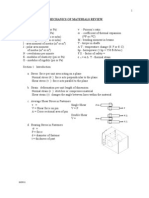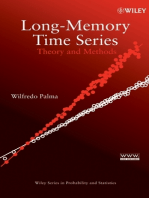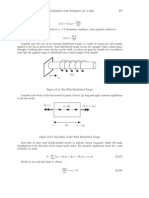y dA = rdrdθ: xθ xθ xθ xθ xθ
Uploaded by
manmathky dA = rdrdθ: xθ xθ xθ xθ xθ
Uploaded by
manmathk274CHAPTER 12.
STRESS AND DEFORMATION ANALYSIS OF LINEAR ELASTIC BARS IN TORSION Stresses (Constitutive Equations) For an elastic, isotropic material, we can write the stress-strain relation as
x = where
E E E x x = = x = Gx (1 + ) (1 + ) 2 2(1 + )
(12.5)
G = shear modulus = Equilibrium equations (COLM)
E 2(1 + )
Note that these stresses must satisfy the equilibrium equations to be a valid state of stress. The static equilibrium equations reduce to (for the case of no body forces):
y equilibrium : z equilibrium :
xy x zx x
= 0 = = 0 =
d2 dx2 d2 dx2
=0 =0
d = constant dx
(12.6)
The last result requires that varies linearly with x. Stress Resultant (equilibrium between internal stress and internal torque) At any point x along the length of the bar, the internal torque Mt must be in equilibrium with the moment produced by the internal shear stress x .
dA = rdrd
x z
r x Mt
Figure 12.10: Equilibrium of Shear Stress and Internal Torque on Cross-Section The moment caused by the shear stress x acting over a dierential area dA located at a distance r from the x-axis (center of the cross-section) is given by r(x dA). Thus the total moment on the
You might also like
- State of Stress Caused by Combined Loadings-SNo ratings yetState of Stress Caused by Combined Loadings-S21 pages
- UEME1263 - Topic 1 - Uniaxial Stress and StrainNo ratings yetUEME1263 - Topic 1 - Uniaxial Stress and Strain104 pages
- 2001, W. E. Haisler Chapter 12: Torsion of Circular BarsNo ratings yet2001, W. E. Haisler Chapter 12: Torsion of Circular Bars28 pages
- 10.Concepts of Force-Stress and Deformation-StrainNo ratings yet10.Concepts of Force-Stress and Deformation-Strain17 pages
- Mechanics of Materials Lecture Notes PDFNo ratings yetMechanics of Materials Lecture Notes PDF130 pages
- 10 - Fundamental Aspects of Torsional LoadingNo ratings yet10 - Fundamental Aspects of Torsional Loading9 pages
- Non - Uniform Torsion of Thin Walled Cross SectionsNo ratings yetNon - Uniform Torsion of Thin Walled Cross Sections3 pages
- CE-103 Mechanics of Solids - I: Dr. Junaid Ahmad Nice, Scee, NustNo ratings yetCE-103 Mechanics of Solids - I: Dr. Junaid Ahmad Nice, Scee, Nust29 pages
- Httpselearning - Meu.edu - Jopluginfile.php879959mod resourcecontent0CH1 PDFNo ratings yetHttpselearning - Meu.edu - Jopluginfile.php879959mod resourcecontent0CH1 PDF80 pages
- Cross Sectional Properties of Thin-Walled Composite Beams: 16 International Conference On Composite MaterialsNo ratings yetCross Sectional Properties of Thin-Walled Composite Beams: 16 International Conference On Composite Materials7 pages
- 0000 - Presentation - Isotropic linear elastic solidsNo ratings yet0000 - Presentation - Isotropic linear elastic solids18 pages
- Lecture 9-Bending and Transverse Shear (20 April 2023-DELIVERED)No ratings yetLecture 9-Bending and Transverse Shear (20 April 2023-DELIVERED)34 pages
- z a u u a φ: u u u - Strains (Kinematics)No ratings yetz a u u a φ: u u u - Strains (Kinematics)1 page
- CH 01 Simple Stresses and Strains VG 24No ratings yetCH 01 Simple Stresses and Strains VG 2440 pages
- ME302: Materials Mechanics: Chap. 1 StressNo ratings yetME302: Materials Mechanics: Chap. 1 Stress16 pages
- ME2112 - (Part 1) - Shear Stress in Beams-L1No ratings yetME2112 - (Part 1) - Shear Stress in Beams-L18 pages
- Mathematics 1St First Order Linear Differential Equations 2Nd Second Order Linear Differential Equations Laplace Fourier Bessel MathematicsFrom EverandMathematics 1St First Order Linear Differential Equations 2Nd Second Order Linear Differential Equations Laplace Fourier Bessel MathematicsNo ratings yet
- Deep Thought: Torsion: A Threat To Mankind !No ratings yetDeep Thought: Torsion: A Threat To Mankind !1 page
- Problem 12.6: 2,200 LB - FT 2 in 8 in PsiNo ratings yetProblem 12.6: 2,200 LB - FT 2 in 8 in Psi1 page
- 12.2. Theoretical Development For Torsion of A BarNo ratings yet12.2. Theoretical Development For Torsion of A Bar1 page
- Axial Load Cell Torsion Load Cell Upper Jaw Grip Circular Rod SpecimenNo ratings yetAxial Load Cell Torsion Load Cell Upper Jaw Grip Circular Rod Specimen1 page
- 12.2. Theoretical Development For Torsion of A Bar: (X + X) (X) (X) (X)No ratings yet12.2. Theoretical Development For Torsion of A Bar: (X + X) (X) (X) (X)1 page
- 12.2. Theoretical Development For Torsion of A BarNo ratings yet12.2. Theoretical Development For Torsion of A Bar1 page
- Free-Body Cut: X Direction On The Left Face (TorqueNo ratings yetFree-Body Cut: X Direction On The Left Face (Torque1 page
- Stress and Deformation Analysis of Linear Elastic Bars in TorsionNo ratings yetStress and Deformation Analysis of Linear Elastic Bars in Torsion1 page
- 12.2. Theoretical Development For Torsion Of A Bar: y a a u u φ θ r u a a y y a φ aNo ratings yet12.2. Theoretical Development For Torsion Of A Bar: y a a u u φ θ r u a a y y a φ a1 page























































































